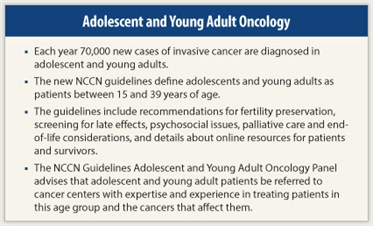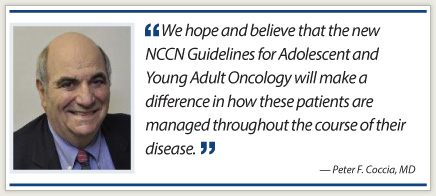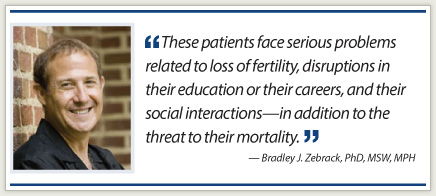 The National Comprehensive Cancer Network (NCCN) announced that it has issued new NCCN Clinical Practice Guidelines in Oncology for Adolescent and Young Adult (AYA) Oncology.1 Adolescent and young adult patients are defined in the guidelines as individuals 15 to 39 years of age at initial cancer diagnosis. The guidelines address the critical issues that adolescent and young adult patients with cancer and their caregivers encounter at diagnosis, during treatment, and after therapy.
The National Comprehensive Cancer Network (NCCN) announced that it has issued new NCCN Clinical Practice Guidelines in Oncology for Adolescent and Young Adult (AYA) Oncology.1 Adolescent and young adult patients are defined in the guidelines as individuals 15 to 39 years of age at initial cancer diagnosis. The guidelines address the critical issues that adolescent and young adult patients with cancer and their caregivers encounter at diagnosis, during treatment, and after therapy.
According to the American Cancer Society’s CA: A Cancer Journal for Clinicians, remarkable progress has been made in the treatment of children under the age of 15 and in adults over 40 years of age in the past 35 years. However, there has been minimal improvement in the survival rate in the 70,000 new adolescent and young adult patients with invasive cancer diagnosed yearly.2
Urgent Need
 “There is an urgent need for increased awareness of the many unique issues responsible for these poor outcomes in the adolescent and young adult oncology patients,” noted Peter F. Coccia, MD, of the UNMC Eppley Cancer Center at The Nebraska Medical Center, Chair of the NCCN Adolescent and Young Adult Oncology Panel, and a member of the NCCN Board of Directors. “Patients in this age group with pediatric types of cancers such as acute lymphoblastic leukemia and bone and soft tissue sarcomas have better outcomes when treated with aggressive therapies utilized by pediatric oncologists. We also see worse outcomes for adolescent and young adult patients diagnosed with adult onset cancers such as breast and colon cancer. We hope and believe that the new NCCN Guidelines for Adolescent and Young Adult Oncology will make a difference in how these patients are managed throughout the course of their disease.”
“There is an urgent need for increased awareness of the many unique issues responsible for these poor outcomes in the adolescent and young adult oncology patients,” noted Peter F. Coccia, MD, of the UNMC Eppley Cancer Center at The Nebraska Medical Center, Chair of the NCCN Adolescent and Young Adult Oncology Panel, and a member of the NCCN Board of Directors. “Patients in this age group with pediatric types of cancers such as acute lymphoblastic leukemia and bone and soft tissue sarcomas have better outcomes when treated with aggressive therapies utilized by pediatric oncologists. We also see worse outcomes for adolescent and young adult patients diagnosed with adult onset cancers such as breast and colon cancer. We hope and believe that the new NCCN Guidelines for Adolescent and Young Adult Oncology will make a difference in how these patients are managed throughout the course of their disease.”
The NCCN Guidelines address the many factors responsible for the disappointing results in adolescent and young adult patients. In the United States, only about 10% of 15- to 19-year-old patients and 1% to 2% of 20- to 39-year-old patients enroll in clinical trials. Conversely, more than 90% of children under 15 years of age are managed in centers that participate in the Children’s Oncology Group protocols or clinical trials. In addition, adolescent and young adult patients more often lack adequate health insurance, and may not have access to either routine health care—which leads to earlier diagnosis—or to state-of-the-art care once diagnosed. Moreover, adolescent and young adult patients tend to be less compliant with their prescribed treatments.
Referral to Experienced Cancer Centers
The NCCN Guidelines Panel, made up of experts in adolescent and young adult oncology from the 21 NCCN Member Institutions, strongly advises that adolescent and young adult patients be referred to cancer centers with expertise and experience in treating patients in this age group and the cancers that affect them. They cite improved enrollment in clinical trials, the need for a multidisciplinary approach to treatment, and specific attention to the special physical and psychosocial issues that adolescent and young adult patients face as critical components in delivering state-of-the-art care.
The NCCN Guidelines include recommendations for fertility preservation, screening recommendations for late effects after successful completion of therapy, palliative care and end-of-life considerations when curative therapy fails, and details about available online resources for adolescent and young adult patients and cancer survivors.
Psychosocial Issues
 Bradley J. Zebrack, PhD, MSW, MPH, of the University of Michigan Comprehensive Cancer Center, a member of the NCCN Adolescent and Young Adult Oncology Panel, stresses the importance of understanding and managing psychosocial issues for these patients.
Bradley J. Zebrack, PhD, MSW, MPH, of the University of Michigan Comprehensive Cancer Center, a member of the NCCN Adolescent and Young Adult Oncology Panel, stresses the importance of understanding and managing psychosocial issues for these patients.
“Psychological distress is significantly greater among adolescent and young adult patients as compared to younger children or older patients with cancer,” he said. “These patients face serious problems related to loss of fertility, disruptions in their education or their careers, and their social interactions—in addition to the threat to their mortality. These issues—and the isolation that accompanies them—can affect their lives for many years. Managing these patients medically and communicating effectively with them can be challenging, and requires that the full team of health-care providers be knowledgeable about adolescent behavior. The team must also be well trained in how to communicate with teens and young adults, as well as their families and peers. The new NCCN Guidelines include a comprehensive psychosocial assessment to assure that these issues are fully addressed.”
The NCCN Guidelines for Adolescent and Young Adult Oncology were presented at the NCCN 17th Annual Conference: Clinical Practice Guidelines & Quality Cancer Care. Access to the NCCN Guidelines for Adolescent and Young Adult Oncology or any of the NCCN Guidelines are available free of charge at NCCN.org. ■
References
1. NCCN Clinical Practice Guidelines in Oncology (NCCN Guidelines): Adolescent and Young Adult (AYA) Oncology. Version 1.2012. Available at http://www.nccn.org/professionals/physician_gls/pdf/aya.pdf. Accessed March 16, 2012.
2. Bleyer A: Young adult oncology: The patients and their survival challenges. CA Cancer J Clin 57:242-255, 2007.

